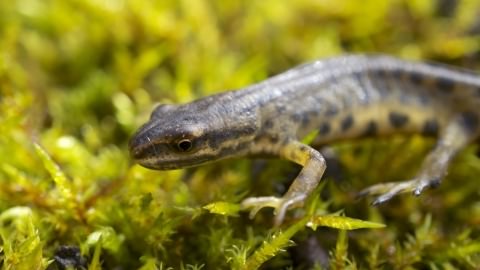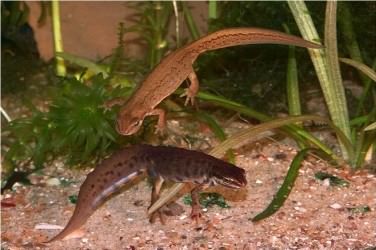
Female
Photo ©2013 Ian Kirk
Click any photo for a larger image

Male & Female
Photo ©2005 Henk Wallays
More photos
Female
Photo ©2013 Ian Kirk
Click any photo for a larger image

Male & Female
Photo ©2005 Henk Wallays
Common newt - Lissotriton vulgaris
Family - Salamandridae
Was known as - Triturus vulgaris
(Lacerta vulgaris, Linnæus, 1758 obsolete)
As its name might suggest The Common Newt, also called the Smooth Newt or Northern Smooth Newt, is our commonest species of newt. It is widespread in the UK and Ireland, near Europe through to Siberia and the Caucasus, it is an introduced pet species to Australia when it was declared a "controlled pest animal" in 1997 from the risk of spread to the wider environment. They have an overall olive green to pale brown colouration with an orange underside graduated to white on the throat, black splotches which are more noticeable on the underside especially in males during the breeding season, these black patches are smaller on the female. Albinistic (pale) and leucistic (dark) individuals have been described. The spots on the throat provide a good way of telling this species apart from Palmate Newts which lack spots on their throat.
They can reach a length of 8–11cm (3.1–4.3in), with males being larger than females which are around 8–9.5cm (3.1–3.7in). The skin is dry and velvety whilst they are in their terrestrial phase moving to water based habitats in the breeding season. Breeding males develop a much brighter and vivid colouration with a wavy ragged crest on their back. They hibernate on land (but can be active during mild weather), often in small groups under logs, in burrows or other suitable sheltered habitats.
Mostly land based during the year, Common newts inhabit darker damp areas where they are mostly nocturnal. They can found in a wide range habitats including forests, field margins, parks and urban gardens where they will readily colonise garden ponds. They feed mainly on various invertebrates such as insects or earthworms and are themselves predated by fish, birds and snakes. During spring and early summer, they move to an aquatic lifestyle to breed in ponds or similar water bodies. Females lay 100–500 eggs, usually folding them into the leaves of water plants, with the larvae hatching after 10–20 days. They further develop over the next three months before metamorphosing into terrestrial juveniles (sometimes called Efts). Sexual maturity is reached after two to three years, and adults can reach an age of up to 14 years.
The Common newt is common over much of its range and classified as a Species of Least Concern species by the IUCN, but suffering from by habitat fragmentation and degradation. It is listed as a protected species in the Berne Convention. Common newts are protected by law under the Wildlife and Countryside Act 1981 in Great Britain, it is illegal to sell or trade them in any way. In England and Wales, they are protected under Schedule 2 of The Conservation of Habitats and Species Regulations 2017 and in Scotland under Schedule 2 of the The Conservation (Natural Habitats) Regulations 1994.
Site design ©1999– Brickfields Country Park - Privacy -